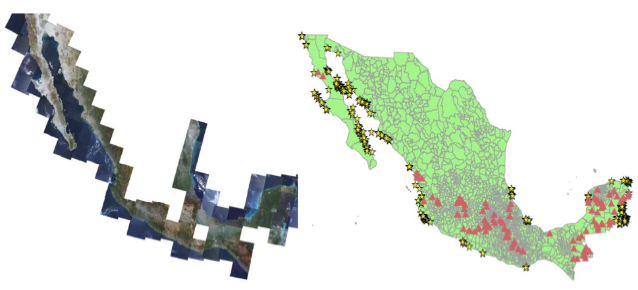
Tourism leads to long-run economic gains locally and in the aggregate. The local gains are in part driven by positive spillovers on manufacturing.
Tourism has become one of the most visible and fastest growing facets of globalisation in developing countries, where tourism exports have grown at an average annual rate of 11% over the period 1982–2012. In the past decade, tourism exports exceeded manufacturing exports for 40% of developing countries, and agricultural exports for half of them.1
Unsurprisingly in this context, tourism has attracted widespread policy attention.[2] At the same time, there is little consensus or existing empirical evidence on its long-term economic consequences. While some governments and international organisations advocate the promotion of tourism to foster economic development in economically lagging regions, opponents have argued that tourism gives rise to a particular form of ‘Dutch disease’ (Copeland 1991). Indeed, a conventional view in the literature on economic growth and development is that the production of traded goods is subject to dynamic productivity improvements, while the services sectors are perceived to be more stagnant. The development of tourism reallocates factors of production towards services activities, such as gastronomy and hotels, and away from traded sector production with higher potential for agglomeration forces and productivity growth. In this view, tourism could therefore give rise to adverse economic effects in the long run.
Tourism in Mexico
In recent work, we use the empirical context of Mexico to study the long-term economic consequences of tourism both locally and at the level of the country as a whole (Faber and Gaubert 2017). In Mexico, tourism has grown to become an important economic force since the 1950s, which was in part facilitated by significant public investments in tourism infrastructure.
We begin the analysis by estimating the local effects of tourism on current-day municipality-level economic outcomes. Tourism in Mexico has had more than half a century to materialise into today's observed distribution of regional economic outcomes. In this context, our empirical strategy aims to exploit cross-sectional variation to capture the long-term effects of tourism exposure on relative regional economic outcomes.
To do so convincingly, we exploit geological and oceanographic variation in beach quality along the Mexican coastline to construct instrumental variables for tourism attractiveness, such as the presence of a nearby offshore island or the fraction of onshore coastline covered by white sand. We also use the presence of pre-Hispanic archaeological sites to construct an additional instrument. Figure 1 depicts the GIS and satellite data that we use to construct these three instrumental variables.
Figure 1 Beach characteristics along the coastline and archaeological ruins in Mexico

Notes: The left panel displays the remote sensing satellite data covering the Mexican coastline at a resolution of 30x30 meter. In the right panel, the stars indicate the location of islands within 5 km from the Mexican coastline, and the triangles indicate the location of pre-Hispanic archaeological ruins.
Empirical evidence
Using this design, we find that variation in tourism activity has strong and significant positive effects on local economic activity relative to less touristic regions. A 10% increase in local tourism revenues leads to a 2.5% increase in employment and a 4% increase in municipality GDP. Interestingly, these effects appear to be in part driven by sizable local multiplier effects on traded sector production. We find that a 10% increase in local tourism revenues leads to a 3.9% increase in local manufacturing GDP. This effect holds for manufacturing sectors that are not intensively used as inputs in the production of tourism-related services.
Evidence of these local effects of tourism, while interesting in its own right, can only shed light on the relative effects across regions, and does not reveal the aggregate effects common across all regions. Furthermore, the observed positive effect of tourism on local manufacturing production does not by itself provide prima facie evidence for positive productivity spillovers from tourism development onto manufacturing. In a world with trade costs, labour mobility, and input-output linkages, the net effect of tourism development on local manufacturing is a priori ambiguous and could be positive through neoclassical demand linkages alone. We also document that higher tourism attractiveness leads to improvements in transport infrastructure that could benefit local manufacturing producers regardless of local tourism activity.
Spatial equilibrium
To investigate these channels and shed light on their aggregate implications, we combine the empirical evidence with a quantitative spatial equilibrium model. We build on the theoretical framework developed by Allen and Arkolakis (2014) and Ahlfeldt et al. (2015), and extend it along several dimensions to capture the economic forces that are relevant in our context. In addition to trade in goods and migration across regions, the model features trade in tourism-related services via travelling consumers across regions and countries, input-output linkages between tourism, manufacturing, and non-traded services, public tax-financed capital investments as inputs to tourism development, and both within and cross-sector local production externalities.
To quantify these forces, we estimate the model parameters and calibrate the model to current-day Mexico as a reference equilibrium. In particular, we estimate the intensity of the within and cross-sector spillovers using an approach that combines model-based indirect inference with the exclusion restrictions of our IVs. We find that both within and cross-sector agglomeration economies are necessary to rationalise the observed local effects of tourism on Mexican regions, while accounting for a host of neoclassical linkages between tourism and manufacturing that the model captures. In addition to the conventional within-manufacturing agglomeration economies, we find that tourism – through its effect on the development of the local services sector – leads to positive spillovers on local traded goods production.
Findings
Armed with the model parameters and a number of observed moments in our data, we proceed to explore general equilibrium counterfactuals. We find that tourism causes significant gains to the average Mexican household that are in the order of 4.8% of household consumption after taking into account the cost of tax-financed investments in Mexican tourism development over the past decades. About 40% of these gains are driven by international tourism, and the remainder by domestic tourism across Mexican regions.
Turning to the underlying channels, we find that about 60% of the observed effect on local GDP can be explained by neoclassical forces, including the direct effect due to local tourism expenditures and indirect effects on other sectors through migration and input-output linkages. The remainder of the local effect on GDP is driven by gains in local manufacturing activity due to both cross and within-sector agglomeration forces. In the aggregate, however, we find that these spillover effects contribute relatively little (about one tenth) to the estimated welfare gains. That is, while the presence of within and cross-sector spillovers reinforce one another leading to the large observed re-allocations of economic activity towards touristic regions, we find that they largely offset one another at the aggregate level, so that the aggregate gains from trade in tourism are mainly driven by a classical market integration effect.
Concluding remarks
To conclude, we hope that our analysis can serve to inform currently ongoing policy debates and future research in two main ways.
- First, we provide credible empirical evidence on the long-term effects of tourism activity on economic outcomes, both locally and in the aggregate. Given that most of the current tourism policies are targeted at improving the local attractiveness for tourism through public investments, as captured in our model, our results on the implications of tourism integration are directly related to these policies.
- Second, this research provides a methodology combining empirical evidence with a spatial equilibrium model that can be useful to study the propagation of localised and sector-specific economic shocks to aggregate outcomes in other empirical contexts of interest.
References
Ahlfeldt, G M, S J Redding, D M Sturm and N Wolf (2015), “The economics of density: Evidence from the Berlin wall”, Econometrica 83(6): 2127–2189.
Allen, T and C Arkolakis (2014), “Trade and the topography of the spatial economy”, Quarterly Journal of Economics 129(3): 1085–1139.
Copeland, B R (1991), “Tourism, welfare and de-industrialization in a small open economy”, Economica 58: 515–529.
Faber, B and C Gaubert (2017), “Tourism and economic development: Evidence from Mexico’s coastline”, NBER Working Paper No. 22300.
Hawkins, D E and S Mann (2007), “The World Bank’s role in tourism development”, Annals of Tourism Research 34(2): 348–363.
Endnotes
[1] These figures are based on UNCTAD statistics.
[2] See, for example, Hawkins (2007) for a review of tourism policies.


